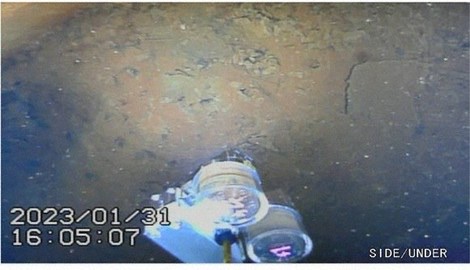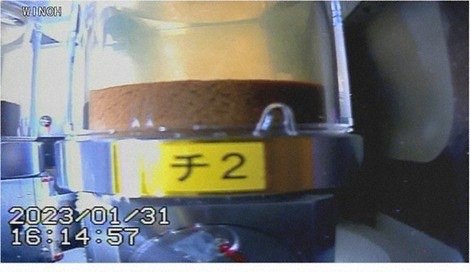

Fukushima Daiichi Nuclear Power Station # 1:ロボットでデブリを採取!
collecte de débris avec un robot !
Trümmer einsammeln mit roboter!
Collecting debris with a robot!
用水下機器人收集碎片!
ーデブリ堆積物の組成を解明へー
東京電力:福島第1原発1号機
2月1日東京電力が、
「原子炉格納容器の底部にたまった堆積物を、水中ロボットで採取した」と発表した。
「溶け落ちた核燃料デブリと、その上にたまった堆積物」が、2層構造になっている。
デブリを取り出すには、「デブリ堆積物の組成を解明すること」が課題だ。
ロボットでデブリ採取:
東電は今回、2地点で採取した。
今後再度ロボットを投入して、別の2地点でも採取の予定。
デブリの入った容器:
堆積物の入った容器は、1時間当たり最大約0・65㎜シーベルトだった。
規定の放射線量(2㎜シーベルト)を下回っており、原子炉格納容器から取り出した。
今後、放射線を遮る容器に移し替えて、分析施設に移送する。
(毎日新聞) – Yahoo!ニュース
https://news.yahoo.co.jp/articles/cd37d5abfbdb35cb40f1eac852164060082f18c1
Unité 1 de la centrale nucléaire de Fukushima Daiichi : collecte de débris avec un robot sous-marin !
– Élucider la composition des dépôts de débris –
Tokyo Electric Power Company : Unité 1 de la centrale nucléaire de Fukushima Daiichi
Le 1er février, TEPCO
“Nous avons collecté des sédiments au fond de la cuve de confinement à l’aide d’un robot sous-marin”, a annoncé la société.
Il a une structure à deux couches de “débris de combustible nucléaire fondu et des sédiments qui s’y sont accumulés”.
Afin d’extraire les débris, le défi consiste à élucider la composition des dépôts de débris.
Collecte de débris robotisée :
TEPCO a collecté des échantillons à deux endroits cette fois.
À l’avenir, nous prévoyons de réintroduire le robot et de le récupérer à deux autres endroits.
Conteneur à débris :
Le récipient contenant le sédiment avait un maximum d’environ 0,65 mm de sievert par heure.
Il était inférieur à la dose de rayonnement prescrite (2 mm sievert) et a été retiré de l’enceinte de confinement du réacteur.
Désormais, il sera transféré dans un conteneur de radioprotection et transféré vers une installation d’analyse.
(Mainichi Shimbun) – Nouvelles de Yahoo!
Kernkraftwerk Fukushima Daiichi Block 1: Trümmer einsammeln mit einem Unterwasserroboter!
– Zur Aufklärung der Zusammensetzung von Schuttablagerungen –
Tokyo Electric Power Company: Kernkraftwerk Fukushima Daiichi Block 1
Am 1. Februar hat TEPCO
„Wir haben mit einem Unterwasserroboter Sedimente vom Boden des Sicherheitsbehälters gesammelt“, kündigte das Unternehmen an.
Es hat eine zweischichtige Struktur aus “geschmolzenem Kernbrennstoffschutt und den darauf angesammelten Sedimenten”.
Um den Schutt zu extrahieren, besteht die Herausforderung darin, die Zusammensetzung der Schuttablagerungen aufzuklären.
Robotische Müllabfuhr:
TEPCO sammelte diesmal Proben an zwei Orten.
In Zukunft planen wir, den Roboter wieder einzuführen und an zwei weiteren Standorten zu sammeln.
Abfallbehälter:
Der Behälter mit dem Sediment hatte maximal etwa 0,65 mm Sievert pro Stunde.
Sie lag unterhalb der vorgeschriebenen Strahlendosis (2 mm Sievert) und wurde aus dem Reaktorsicherheitsbehälter entfernt.
Von nun an wird es in einen Strahlenschutzbehälter umgefüllt und einer Analyseeinrichtung zugeführt.
(Mainichi Shimbun) – Yahoo!-Nachrichten
TEPCO: Fuel debris samples taken from damaged Fukushima Daiichi nuclear reactor
NHK WORLD-JAPAN News
The operator of the crippled Fukushima Daiichi nuclear power plant says
it has retrieved samples from inside the No. 1 reactor containment vessel.
It says the samples are likely to contain fuel debris.
The plant suffered
a triple meltdown in the March 2011 earthquake and tsunami.
Its operator,
Tokyo Electric Power Company, or TEPCO,
said on Wednesday that underwater robots successfully sucked water out from two locations inside the vessel.
The company has been examining the inside of the No.1 reactor containment vessel.
It says
the accumulated matter at the bottom is thought to contain fuel debris.
The project
to collect samples initially began early last month, but was suspended due to technical errors.
It was resumed on Tuesday.
Experts hope that
a close analysis of the samples will help lead to successful removal of fuel debris — one of the greatest challenges in the plant’s decommissioning process.
TEPCO said
it will try taking samples from two other locations inside the vessel.
It also said
it will spend about a year identifying the types and amounts of chemical elements contained in the samples.
The company also plans
to send robotic cameras inside the pedestal, a structure that props up the reactor.